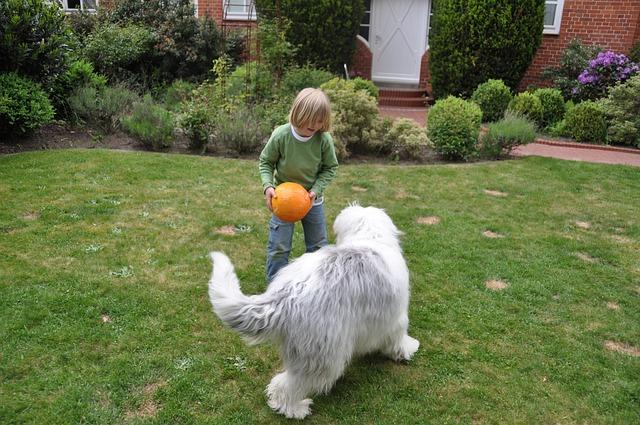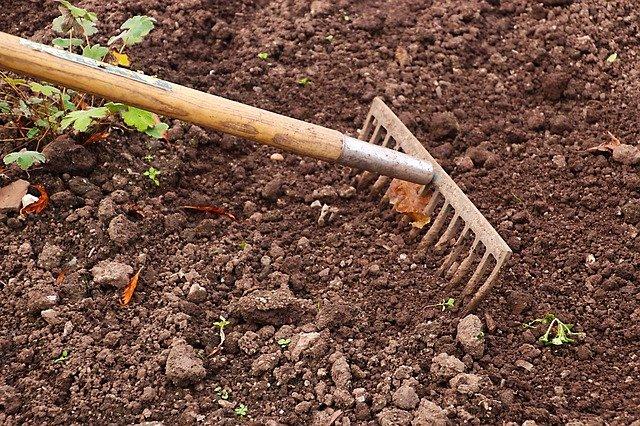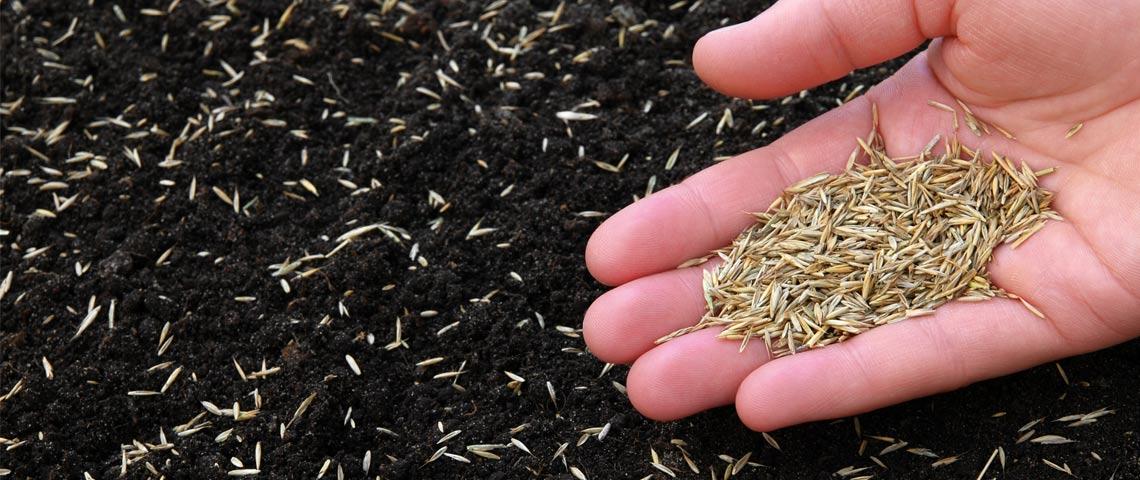Key points
- Most Maryland lawns are started from seed. Turf-type tall fescue is the recommended type of grass for the entire state.
- Timing is critical for success.
- Late summer to early fall (mid-August to mid-October) is the best time for seeding cool-season grasses like tall fescue.
- Seed in August if autumn leaf drop is a concern.
- The second best time to seed is early March through April.
- Seed planted at other times tends to fail because weather conditions are not favorable for growth (too hot, dry, or cold) and from weed competition.
Questions to consider before starting a lawn in Maryland

1) What are some of the challenges of growing a lawn in Maryland?
A year-round deep green lawn is not an attainable goal in Maryland. The state is located in the transition zone (an area where temperate and subtropical climates meet). We can grow both cool-season grasses like tall fescue and warm-season grasses like zoysia but weather conditions are not favorable for either the entire year. Cool-season grasses go dormant in the summer and warm-season grasses go dormant in the fall.
2) How much sunlight does the area receive?
Grass needs a sunny location to grow well. Most grass types need 4-6 hours of direct sunlight. Shady lawns thin out and moss and other weeds move in. Consider lawn alternatives if the area is shady or has trees.
3) What kind of foot traffic will the lawn receive? Will this be a play area for children or dogs?
Foot traffic causes a lot of wear and tear on a lawn. Plan on spending more time and effort to keep the grass healthy if the lawn will be heavily used. Foot traffic causes soil compaction and grassroots do not grow well in compacted soil. Core aeration and overseeding in the fall will help to correct this. Fertilize the lawn in the fall for root development. Mulch around a swing set area instead of planting grass. Ideally, designate an area in your yard for your dogs that limits lawn access.
4) Is this a new home site? Does the soil need to be amended?
On new home sites, it is a common practice for the topsoil to be removed during construction. The remaining subsoil is less fertile, compacted, and often building debris, stones, and rubble is left behind. This soil produces a poor quality lawn. Ideally, improve the soil before planting by mixing compost into the top 6 inches of the soil and raking out any debris and rocks.
5) Will overseeding be sufficient to improve the quality of your lawn or must you perform complete lawn renovation?
If a lawn area has more than 40-50% weeds or the lawn has been left unmanaged for a period of time, total lawn renovation is most likely needed. Removing or killing the existing vegetation then reseeding or installing sod takes a lot of effort. Begin a lawn maintenance program to prevent this from happening again.
Comparing cool season and warm season grasses
| Cool-season (grows actively in the spring and fall) | Warm-season (grows actively in the late spring and summer) |
|---|---|
|
Turf-type tall fescue, Kentucky bluegrass, fine fescue |
Zoysiagrass and bermudagrass |
| Depending on rainfall may remain green throughout the year. Can go dormant in summer droughts | Goes dormant from mid-October through mid-May. Turns a tannish-brown color after the first frost |
| Higher maintenance required, although tall fescue requires less maintenance than Kentucky bluegrass | Zoysiagrass requires less nitrogen fertilizer compared to cool-season turf However, periodic dethatching is necessary |
| Best time to establish is later summer or early fall. Start from seed or sod | Establish in late spring. Start by planting plugs or sod |
Types of grass planted in Maryland
Turf-type tall fescue
- Adapts to a wide range of soil and sunlight conditions but does best in full sun to moderately shady locations. It is recommended for most Maryland home lawns.
- The most drought-tolerant grass and least prone to disease and insect problems compared to other types of turfgrass.
- A bunch-type grass that performs best on open, sunny sites in well-drained soil.
- Started from seed or sod. Seed germinates in 7 to 14 days.
Kentucky bluegrass
- Popular because of its medium-to-fine leaf texture and rich medium-to-dark green color.
- Bluegrass is a higher maintenance turf than tall fescue. Periodic dethatching and more fertilizer applications are required.
- Has a higher incidence of disease problems, especially summer patch, and is more sensitive to drought damage and Japanese beetle grub feeding.
- Performs best on open, sunny sites in well-drained soils. Does not grow well in the shade.
- Spreads by an extensive system of underground stems called rhizomes.
- Started from seed or sod. Seed germinates in 14 to 21 days.
Fine fescues
- Fine-bladed grasses comprised of creeping red fescue, hard fescue, chewings fescue, and sheep fescue that can be planted in shadier locations. Hard fescues will also do well in sunny low-maintenance locations as well.
- Not recommended for areas with frequent foot traffic.
- Among cool-season grasses, fine fescue grasses can be successful for use as low maintenance turf on sites that are difficult to maintain.
- Fine fescues need well-drained soil. They should not be mowed during periods of heat stress and drought. One fall application of fertilizer is recommended.
- They are prone to thatch build-up and periodic dethatching is recommended.
- Started from seed. Seeds germinate in 7 to 14 days.
Perennial ryegrass
- A medium-textured bunching grass with deep green blades.
- A pure perennial ryegrass lawn is not recommended because of disease susceptibility. Gray leaf spot is a serious disease problem.
- Commonly used in seed mixtures because it germinates quickly; should not exceed 5-15% of the mixture because it is not long-lasting due to disease problems.
- Started from seed. Seed germinates in 5 to 10 days.
Zoysiagrass
- An excellent low maintenance lawn in full sun.
- Recommended for the warmer areas in Maryland such as southern Maryland and the eastern shore.
- The blades are wiry and are fine-to-medium textured.
- Drought tolerant and not susceptible to diseases.
- Established by plugs (more information below) or sod.
Bermudagrass
- Requires full sun.
- Deeply rooted and is used on high-traffic areas such as athletic fields.
- Winter hardiness can be a concern.
- Not typically recommended for home lawns.
Check (PDF) UMD TT-77 Recommended Turfgrass Cultivars for Certified Production and Seed Mixtures in Maryland for more information on grass cultivars and seed.
Plugs
- Warm-season lawns are typically established by vegetative means, not from seed. Plugs are small pieces of sod that are planted at regular intervals.
Planting plugs
- Planted in mid to late May, when warm-season turf begins to green up.
- Planted like any other small plant. Small holes can be made with a trowel, small spade, or some type of bulb planter. They should be planted 6 to12 inches apart. The closer they are spaced, the faster they will fill in.
- Irrigate immediately after plugging. Do not let the area dry out. Lightly water the area daily. When the weather is hot and dry, two or three light daily waterings may be required.
- It is important to keep weeds from becoming established between the plugs. Manage weeds by handpulling or cutting off at ground level using a hoe.
Site preparation steps

- Perform a soil test. Soil testing provides important information such as pH, nutrient levels, and amount of organic matter (most labs test for this as part of the basic soil test).
- Rough grade. The grade should slope away from buildings eliminating any low spots that could cause poor drainage. A 1-2 percent slope or dropping about 2-3 inches every 10 feet is recommended. The grade around existing trees should not be altered because damage to the trees will eventually occur. All debris including, large stones, excess building material, and roots should be removed. If purchasing topsoil is necessary to correct the grade, to fill in lawn low spots, or to incorporate into the existing soil (some soil vendors sell a mixture of topsoil and compost), ask for a soil test report and where it came from. Do not purchase topsoil that is full of rocks and debris, is gray or white in color, has a bad odor, or a sticky, gummy texture.
- Add soil amendments. Properly prepared soil is crucial for the success of your lawn. After your lawn is planted it is difficult and costly to go back to make improvements to the soil. Till or incorporate into the top 4-6 inches of soil the amount of lime and fertilizer that was recommended from your soil test results. Never till soil that is too wet, and avoid overtilling because damage to the soil structure will occur. Apply and rake in a 1-2 inch layer of compost if the soil organic matter level is less than 3% (according to soil test results). One negative aspect of tilling is that it brings weed seeds to the soil surface.
- Do final grading. Rake the area to smooth out low areas and to even out the seedbed. If needed, lightly roll the seedbed before seeding or installing sod with a water roller to firm up the soil. Do not use heavy equipment, because it will compact the soil making it difficult for roots to grow.
- Plant grass seed or lay sod. Divide the seed into two parts; apply one-half in one direction (north/south) and the remainder in the opposite direction (east/west). Sow seed with a lawn spreader. Press seeds into the soil with the back of a metal tine-bow rake or water roller.
- Water and then cover the seedbed with a layer of straw to hold in moisture and protect seeds from hungry birds. There is no need to remove the straw as the seeds germinate and the grass grows. It will break down as you mow.
| Lawn establishment seeding rateTurf-type tall fescue | |
|---|---|
| Turf-type tall fescue | 6-8 lbs. per 1,000 sq. ft. |
| Kentucky bluegrass | 2-3 lbs. per 1,000 sq. ft. |
| Fine fescue | 4-5 lbs. per 1,000 sq. ft. |
By Debra Ricigliano, Maryland Certified Professional Horticulturist, University of Maryland Extension Home and Garden Information Center (retired), 2019. Reviewed and edited by Jon Traunfeld, HGIC Director and Christa Carignan, HGIC Coordinator, Digital Horticulture Education.
Based on HGIC publication HG 102 Lawn Establishment, Renovation, and Overseeding.
Still have a question? Contact us at Ask Extension.
